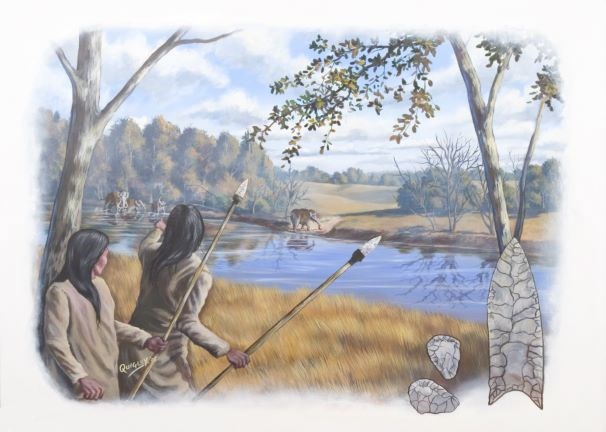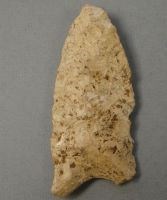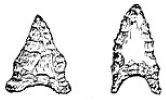
Dean Quigley The current view of the Paleo Indian period envisions bands of hunters entering the North American continent around 17,000 years ago (15,000 BCE) by crossing a land bridge that connected eastern Siberia with Alaska. The land bridge was exposed during the Late Pleistocene by continent-sized glaciers, which, when created, drew water from the oceans, lowering sea levels by some 120 meters. It would appear that these same glaciers prevented these immigrants from expanding across the entire North American continent until about 16,000 years ago (14,000 BCE). The best diagnostic archeological evidence for these early Paleo Indian bands are long, fluted chipped stone projectile points. These early points are named “Clovis” after the Clovis, New Mexico archeological site where the point type was first recognized in association with Late Pleistocene fauna. Within only a few hundred years after 12,000 BCE, the Paleo Indians appear to have occupied most of the North American continent and the southeast. Since 1960, archeological studies of the river basin projects, as well as statewide studies of Paleo Indian point finds and site distributions in the southeast, have led to refinements in the sequencing of point types and attempts to reconstruct Paleo Indian cultural activities. Excavations at Paleo Indian sites, better dating techniques, and study of the distribution of Paleo Indian point types and the Late Pleistocene environment have led archeologists to develop new models for Paleo Indian occupation in the southeast now broken down into three subperiods. 
NPS Clovis spear points characterize the first subperiod, Early Paleo Indian. Archaeologists believe that the distribution of these points throughout all the environmental zones in the southeast represents the initial exploration and colonization of the region. The great mobility of the small Paleo Indian bands of this subperiod is suggested by the finding of stone tools and debitage traded or transported hundreds of kilometers from their quarry source. The southeast, at this time, consisted of three broad environmental zones, running west to east. They were cool-climate boreal forests, temperate oak-hickory-pine forests, and subtropical sandy scrub. The last area was confined to the Florida peninsula and the coastal plain in the southeast, which extended several kilometers outward from its present location due to the lower sea level. Megafauna of the Late Pleistocene were found in these three environmental zones. Middle Paleo Indian Subperiod (13,000 - 11,000 BCE) The second subperiod, the Middle Paleo Indian, is characterized by a number of fluted and unfluted points, both larger and smaller than Clovis points. The point types of this subperiod in the southeast are Cumberland, Redstone, Suwannee, Beaver Lake, Quad, Coldwater, and Simpson. This subperiod is viewed as a time when the population was adapting to optimum environmental resource zones instead of randomly moving throughout the southeast. Concentration on specific zones and resources may account for the variation in the stone points of this subperiod. 
NPS Dalton and other side-notched-style points characterize the last subperiod, the Late Paleo Indian. The replacement of fluted point forms by nonfluted points is believed to reflect a change in the adaptive strategy, away from hunting Late Pleistocene megafauna toward a more generalized hunting of small, modern game, such as deer, and a collecting subsistence strategy within the southern pine forests as they replaced the boreal forests. Chert deposits may have attracted Paleo Indian groups of this subperiod to specific locales in order to replenish their stone tools. Such a tendency may have constrained these groups to a specific landscape, setting the stage for the intensive regional specialization that characterized the succeeding Archaic Period. It is possible that large Paleo Indian sites in the southeast are permanent or semi-permanent base camps from which resources of specific territories were exploited. Trade or transportation of stone tools appears to decrease as Late Paleo Indian groups relied on local materials for their needs. |
Last updated: July 26, 2023
